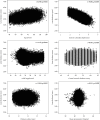Analysis of Lens Thickness Distribution Based on Swept-Source Optical Coherence Tomography (SS-OCT)
- PMID: 35003790
- PMCID: PMC8736696
- DOI: 10.1155/2021/4717996
Analysis of Lens Thickness Distribution Based on Swept-Source Optical Coherence Tomography (SS-OCT)
Abstract
Objective: This study aimed to analyze the distribution of lens thickness (LT) and its associations in age-related cataract patients based on swept-source optical coherence tomography (SS-OCT).
Methods: This cross-sectional study included 59,726 Chinese age-related cataract patients. Only right-eye data were included in the study. Repeated measures of ocular parameters were performed using an IOL Master 700 device. The distributions of ocular biometric data including anterior chamber depth (ACD), LT, axial length (AL), central corneal thickness (CCT), white-to-white (WTW), and mean keratometry (MK) and their associations with age were assessed. The anterior segment (AS) was measured as the sum of CCT, ACD, and LT, while the vitreous chamber depth (VCD) was calculated as the difference between AL and AS. The values of LT : AL, AS : AL, and VCD : AL in different AL groups and their changes are the main outcome measures used to observe the proportion of the anterior and posterior segments of the eye.
Results: Biometric data were available for 59,726 individuals. The mean age was 68.81 years (range = 40-100); 40.62% were male and 59.38% were female. Mean anterior chamber depth (ACD) was 3.02 ± 0.44 mm, mean LT was 4.51 ± 0.44 mm, mean axial length (AL) was 23.89 ± 1.92 mm, mean central corneal thickness (CCT) was 0.53 ± 0.03 mm, mean white-to-white (WTW) was 11.64 ± 0.44 mm, and mean keratometry (MK) was 44.27 ± 1.65 diopter. Female patients had shorter AL, shallower ACD, smaller CCT and WTW, decreased LT, and steeper corneas (p < 0.005). ACD revealed the strongest negative correlation (p ≤ 0.001, r = -0.682) with LT. Age (p ≤ 0.001, r = 0.348) showed a moderate positive correlation, whereas MK (p < 0.05, r = 0.011), CCT (p ≤ 0.001, r = 0.041) had a weak positive correlation and WTW (p ≤ 0.001, r = -0.034) had a weak negative correlation with LT. A nonlinear correlation was found between LT and AL. LT increased with age in both males and females. LT changed variably in eyes with AL less than 27 mm, LT decreased as AL increased, then LT gradually increased as AL increased in extremely long and extra-long eyes (p ≤ 0.001). LT : AL and AS : AL decreased as AL increased, VCD : AL gradually increased as AL increased in highly myopic eyes, and VCD : AL increased by about 0.01 for every 1 mm increase in AL.
Conclusions: Among Chinese age-related cataract patients, we found LT to have the strongest relation with ACD. The lens was thicker in elderly patients and women. The correlation between LT and AL is not a simple negative correlation; with the increase of age, LT decreases first and then increases. The proportion of VCD is constantly rising with the elongation of AL.
Copyright © 2021 Xi Feng et al.
Conflict of interest statement
The authors declare that they have no conflicts of interest.
Figures



Similar articles
-
Assessment of the variability and correlation of biometric measurements in eyes with cataracts.Photodiagnosis Photodyn Ther. 2025 Feb;51:104453. doi: 10.1016/j.pdpdt.2024.104453. Epub 2024 Dec 21. Photodiagnosis Photodyn Ther. 2025. PMID: 39716626
-
Lens thickness and associated ocular biometric factors among cataract patients in Shanghai.Eye Vis (Lond). 2021 May 31;8(1):22. doi: 10.1186/s40662-021-00245-3. Eye Vis (Lond). 2021. PMID: 34053465 Free PMC article.
-
Correlation of vitreous chamber depth with ocular biometry in high axial myopia.Indian J Ophthalmol. 2022 Mar;70(3):914-920. doi: 10.4103/ijo.IJO_1201_21. Indian J Ophthalmol. 2022. PMID: 35225543 Free PMC article.
-
Distribution of ocular biometric parameters and optimal model of anterior chamber depth regression in 28,709 adult cataract patients in China using swept-source optical biometry.BMC Ophthalmol. 2021 Apr 13;21(1):178. doi: 10.1186/s12886-021-01932-4. BMC Ophthalmol. 2021. PMID: 33849464 Free PMC article.
-
Agreement between intraoperative anterior segment spectral-domain OCT and 2 swept-source OCT biometers.Expert Rev Med Devices. 2021 Apr;18(4):387-393. doi: 10.1080/17434440.2021.1905518. Epub 2021 Mar 30. Expert Rev Med Devices. 2021. PMID: 33730515
Cited by
-
Accuracy comparison of six intraocular lens formulas using total and standard keratometry measurements with the iolmaster 700.Sci Rep. 2025 Jul 18;15(1):26095. doi: 10.1038/s41598-025-11332-z. Sci Rep. 2025. PMID: 40681652 Free PMC article.
-
Comparison of anterior segment parameters in myopia with and without primary open-angle glaucoma.Int Ophthalmol. 2023 Jul;43(7):2307-2313. doi: 10.1007/s10792-022-02627-5. Epub 2022 Dec 30. Int Ophthalmol. 2023. PMID: 36583820
-
Correlation of Ocular Biometry with Axial Length in Elderly Japanese.Clin Ophthalmol. 2024 Feb 3;18:351-360. doi: 10.2147/OPTH.S446031. eCollection 2024. Clin Ophthalmol. 2024. PMID: 38332905 Free PMC article.
-
Senile Cataract Formation Does Not Affect Crystalline Lens Thickness.Ophthalmol Ther. 2024 Mar;13(3):819-830. doi: 10.1007/s40123-024-00882-6. Epub 2024 Jan 25. Ophthalmol Ther. 2024. PMID: 38273047 Free PMC article.
-
Refractive Status and Biometric Characteristics of Children With Familial Exudative Vitreoretinopathy.Invest Ophthalmol Vis Sci. 2023 Oct 3;64(13):27. doi: 10.1167/iovs.64.13.27. Invest Ophthalmol Vis Sci. 2023. PMID: 37850946 Free PMC article.
References
LinkOut - more resources
Full Text Sources
Research Materials

